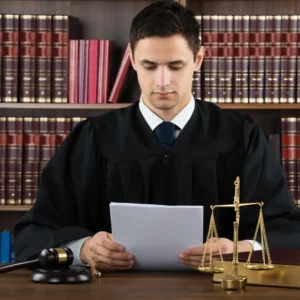The Senior Advocates AOR Supreme Court Mandate 2025 sets a new precedent, with the Supreme Court ruling in SCBA v. State of UP (2025) that Senior Advocates cannot appear without an Advocate-on-Record (AOR). This blog explores the 2013 Supreme Court Rules, the landmark judgment, and its implications for judiciary aspirants—perfect for prelims, mains, and viva voce. Stay updated as of March 18, 2025!
Introduction
The Supreme Court of India delivered a transformative ruling in Supreme Court Bar Association and Anr. v. State of Uttar Pradesh and Ors. (2025 SC), reshaping the landscape of legal practice in India’s apex court. The Senior Advocates AOR Supreme Court Mandate 2025 establishes that no advocate, including Senior Advocates, can appear, plead, or address the Supreme Court without an Advocate-on-Record (AOR), unless instructed by an AOR or permitted by the Court. Justices Bela M. Trivedi and Satish Chandra Sharma underscored the mandatory application of the 2013 Supreme Court Rules, particularly Order IV, in regulating advocate appearances.
This blog logically unfolds the concept of AORs and Senior Advocates, the historical evolution of Supreme Court advocacy, the SCBA v. State of UP judgment, its legal framework, practical implications, and relevance for judiciary exams like PCS J, APO, and JLO. Let’s dive into this pivotal legal update!
1. Inherent Concept: Understanding AORs and Senior Advocates
What is an Advocate-on-Record (AOR)?
An Advocate-on-Record (AOR) is a specialized category of advocate exclusively authorized to file cases and act on behalf of parties in the Supreme Court of India. The AOR system, formalized under the Supreme Court Rules 2013, ensures procedural discipline by making AORs the primary interface between the Court and litigants. To qualify as an AOR, an advocate must:
- Be enrolled with a State Bar Council under the Advocates Act, 1961.
- Have at least 4 years of legal practice and 1 year of training under an existing AOR.
- Pass the AOR examination conducted by the Supreme Court, testing knowledge of Supreme Court procedures and ethics.
AORs are responsible for filing petitions, affidavits, and other documents, ensuring compliance with the Court’s stringent procedural requirements.
What is a Senior Advocate?
A Senior Advocate is an advocate designated by the Supreme Court or a High Court under Section 16 of the Advocates Act, 1961, for their exceptional expertise, experience, and contributions to the legal field. Senior Advocates typically lead arguments in high-stakes cases, commanding significant respect and higher fees. However, their role focuses on advocacy and legal strategy, not procedural filings, which distinguishes them from AORs.
Why This Distinction Matters
The Senior Advocates AOR Supreme Court Mandate 2025 highlights the procedural hierarchy in the Supreme Court: AORs manage filings and logistics, while Senior Advocates provide expert advocacy. This division ensures accountability, streamlines case management, and upholds the Court’s efficiency, a principle central to the recent ruling.
2. Historical Context: Evolution of Advocacy in the Supreme Court
Early Advocacy Norms
The Supreme Court of India, established in 1950, initially adopted advocacy norms from the Federal Court and British traditions. Early rules required advocates to be enrolled with the Court, but the AOR system was formalized later to address the growing caseload and procedural complexities. The Supreme Court Rules of 1966 introduced the AOR framework, mandating their role in filings but allowing flexibility in appearances.
The 2013 Supreme Court Rules
Enacted under Article 145 of the Constitution, the Supreme Court Rules 2013 replaced earlier frameworks, tightening the AOR system:
- Order IV, Rule 1(b): No advocate other than an AOR can appear, plead, or address the Court unless instructed by an AOR or permitted by the Court.
- Order IV, Rule 20: An AOR cannot authorize anyone except another AOR to act on their behalf.
- Order IV, Rule 2(b): A Senior Advocate cannot appear in the Supreme Court without an AOR and must be accompanied by a junior in other courts or tribunals in India.
These rules aimed to standardize appearances, ensuring procedural consistency in the apex court.
Precedent Cases
Cases like Indira Jaising v. Supreme Court of India (2017) addressed Senior Advocate designations, highlighting tensions over advocacy norms. However, the AOR system’s mandatory role remained largely unchallenged until the Senior Advocates AOR Supreme Court Mandate 2025 provided definitive clarity.
3. The SCBA v. State of UP Case: Facts and Detailed Analysis
Case Details: Supreme Court Bar Association and Anr. v. State of Uttar Pradesh and Ors. (2025 SC)
The case originated from a petition filed by the Supreme Court Bar Association (SCBA) and another party, seeking to clarify the rules governing advocate appearances in the Supreme Court. The petitioners argued for flexibility in the 2013 Rules, contending that Senior Advocates and non-AORs should be allowed to appear independently in certain cases, reflecting practical realities of legal practice where Senior Advocates often lead arguments without direct AOR involvement.
Court’s Composition: The matter was heard by a bench comprising Justices Bela M. Trivedi and Satish Chandra Sharma, known for their expertise in procedural law and constitutional matters.
Supreme Court’s Observations
The Senior Advocates AOR Supreme Court Mandate 2025 delivered a clear ruling:
- Mandatory AOR Requirement: No advocate, including Senior Advocates, can appear, plead, or address the Supreme Court without an AOR, unless instructed by an AOR or permitted by the Court.
- 2013 Rules as Binding: While advocates enrolled under the Advocates Act, 1961, have a general right to appear before the Supreme Court, this right is subject to the 2013 Rules framed under Article 145.
- Key Rules Interpreted:
- Order IV, Rule 1(b): Only AORs can represent parties, and non-AORs need AOR instructions or Court permission to appear, plead, or address the Court.
- Order IV, Rule 20: AORs can only delegate their responsibilities to other AORs, not to non-AORs or other persons.
- Order IV, Rule 2(b): A Senior Advocate cannot appear in the Supreme Court without an AOR and must also be accompanied by a junior in other courts or tribunals in India.
Detailed Analysis of the Judgment
The Court’s reasoning in the Senior Advocates AOR Supreme Court Mandate 2025 is rooted in procedural efficiency and judicial discipline:
- AOR as Gatekeeper: The AOR system ensures that all filings and proceedings comply with Supreme Court standards, reducing errors and delays. AORs are trained and examined to handle the Court’s unique procedural demands, making their role indispensable.
- Senior Advocate Restriction: Allowing Senior Advocates to appear without AORs would undermine this system, as they are not responsible for procedural filings. The Court emphasized that Senior Advocates’ expertise lies in advocacy, not logistics, necessitating AOR involvement to maintain order.
- Non-AOR Limitation: Non-AORs, while entitled to practice, lack the specialized training of AORs. Permitting them to appear independently would risk procedural lapses, hence the requirement for AOR instructions or Court permission.
- Constitutional Authority: The 2013 Rules, framed under Article 145, reflect the Supreme Court’s authority to regulate its own proceedings. The Court rejected any interpretation that would dilute this authority, affirming the Rules’ mandatory nature.
Significance of the Ruling
The Senior Advocates AOR Supreme Court Mandate 2025 resolves long-standing ambiguities in Supreme Court practice, ensuring that the AOR system remains the cornerstone of procedural integrity. It also underscores the Court’s commitment to balancing advocates’ rights with administrative efficiency, a principle central to Article 145.
4. Legal Framework: 2013 Supreme Court Rules in Focus
Key Provisions of the 2013 Rules
- Order IV, Rule 1(b): “No advocate other than the Advocate-on-Record for a party shall appear, plead and address the Court in a matter unless he is instructed by the Advocate-on-Record or permitted by the Court.” This ensures that AORs are the primary representatives, maintaining procedural oversight.
- Order IV, Rule 20: “No Advocate-on-Record shall authorise any person whatsoever except another Advocate-on-Record, to act for him in any case.” This prevents delegation to non-AORs, preserving the system’s integrity.
- Order IV, Rule 2(b): “A Senior Advocate shall not appear without an Advocate-on-Record in the Supreme Court and shall not appear without a junior in any other court or tribunal in India.” This dual requirement ensures Senior Advocates are supported by both an AOR (in the Supreme Court) and a junior (elsewhere).
Constitutional Basis
Article 145 of the Constitution empowers the Supreme Court to make rules regulating its practice and procedure, subject to parliamentary law. The 2013 Rules, including Order IV, are thus legally binding, as reaffirmed by the Senior Advocates AOR Supreme Court Mandate 2025.
Advocates Act, 1961
Section 30 of the Advocates Act grants advocates the right to practice before all courts, including the Supreme Court. However, the Supreme Court clarified that this right is not absolute and is subject to court-specific rules like the 2013 Supreme Court Rules. The Senior Advocates AOR Supreme Court Mandate 2025 harmonizes this right with procedural requirements, ensuring no conflict with statutory provisions.
5. Implications of the SCBA v. State of UP Ruling
For Senior Advocates
- Mandatory AOR Collaboration: Senior Advocates must now work closely with AORs, ensuring procedural compliance but potentially increasing costs for clients who hire both.
- Practice Adjustment: Those accustomed to independent appearances must adapt, fostering stronger partnerships with AORs to streamline case management.
For Non-AOR Advocates
- Restricted Role: Non-AORs can only argue if instructed by an AOR or permitted by the Court, limiting their direct engagement in Supreme Court cases.
- Career Incentive: The ruling may encourage more advocates to pursue AOR status, enhancing their role and visibility in apex court practice.
For the Supreme Court
- Procedural Efficiency: Reinforcing the AOR system ensures streamlined case management, reducing procedural errors and delays in the Court’s docket.
- Judicial Discipline: The mandate upholds the Court’s authority under Article 145 to regulate its proceedings, maintaining consistency and order.
For Litigants
- Increased Costs: Hiring both a Senior Advocate and an AOR may raise litigation expenses, potentially affecting access to justice for smaller litigants.
- Procedural Clarity: Litigants benefit from the AOR’s expertise in navigating Supreme Court procedures, ensuring their cases are properly presented.
For Judiciary Aspirants
- Exam Relevance: The Senior Advocates AOR Supreme Court Mandate 2025 is a high-yield topic for 2025 judiciary exams:
- Prelims: MCQs on the 2013 Supreme Court Rules and AOR roles.
- Mains: Essays on the evolving role of advocates in the Supreme Court.
- Viva Voce: Questions on Article 145, Senior Advocate restrictions, and procedural law.
Critical Analysis
The Senior Advocates AOR Supreme Court Mandate 2025 strengthens procedural discipline but raises practical concerns:
- Access to Justice: The mandatory AOR requirement may increase litigation costs, potentially deterring smaller litigants from approaching the Supreme Court.
- Logistical Challenges: Senior Advocates may face difficulties coordinating with AORs, especially in urgent cases like interim relief applications, where time is critical.
- Balancing Flexibility: While the ruling ensures consistency, it may limit the Court’s flexibility to accommodate exceptional circumstances, such as when an AOR is unavailable.
6. Exam Relevance for Judiciary Aspirants
Prelims: MCQs
- Sample: “As per the Senior Advocates AOR Supreme Court Mandate 2025, who can appear without an AOR in the Supreme Court? (a) Senior Advocates (b) Non-AORs (c) None” (Answer: c).
- Tip: Practice 50 MCQs weekly on Supreme Court Rules, Article 145, and recent judgments to master procedural law topics.
Mains: Essays
- Question: “Evaluate the impact of the Senior Advocates AOR Supreme Court Mandate 2025 on Supreme Court practice and access to justice.”
- Answer: Discuss the 2013 Rules, the mandatory AOR system, procedural benefits, and potential cost barriers—aim for 15/20 marks.
Viva Voce: Quick Hits
- Ask: “What does the Senior Advocates AOR Supreme Court Mandate 2025 mean for Senior Advocates in the Supreme Court?”
- Say: “They cannot appear without an AOR, as mandated by Order IV, Rule 2(b) of the 2013 Rules.”
- Tip: Link the ruling to Article 145 and the Advocates Act for a comprehensive response.
7. Practical Examples and Scenarios
Scenario 1: Senior Advocate in a Constitutional Case
A Senior Advocate, Ms. A, is hired to argue a constitutional challenge in the Supreme Court. Under the Senior Advocates AOR Supreme Court Mandate 2025, she must be instructed by an AOR, who files the petition and appears alongside her during hearings. Without an AOR, Ms. A cannot address the Court, ensuring procedural compliance.
Scenario 2: Non-AOR Advocate in a PIL
An advocate, Mr. B, who is not an AOR, wishes to argue a Public Interest Litigation (PIL) in the Supreme Court. Per the Senior Advocates AOR Supreme Court Mandate 2025, he must secure instructions from an AOR or obtain the Court’s permission to plead, ensuring the AOR system’s oversight is maintained.
Scenario 3: Urgent Interim Relief Application
A Senior Advocate seeks to file an urgent interim relief application on behalf of a client. The Senior Advocates AOR Supreme Court Mandate 2025 requires an AOR to file the application and appear, potentially delaying the process if an AOR is unavailable, highlighting a practical challenge of the ruling.
8. Future Outlook and Critical Perspective
Future Trends
- Rise in AOR Registrations: The Senior Advocates AOR Supreme Court Mandate 2025 may lead to an increase in advocates pursuing AOR status, as their role becomes more central to Supreme Court practice.
- Potential Rule Amendments: Post-2025, the Supreme Court may introduce exceptions for urgent cases, allowing Senior Advocates to appear without AORs in exceptional circumstances, balancing efficiency with flexibility.
- Judicial Clarifications: Future cases may test the ruling’s application, particularly in scenarios involving logistical constraints or access to justice concerns.
Critical Perspective
The Senior Advocates AOR Supreme Court Mandate 2025 offers significant benefits but also poses challenges:
- Procedural Discipline: The ruling ensures consistency and accountability in Supreme Court proceedings, reducing the risk of procedural errors that could delay justice.
- Cost Implications: Requiring AORs alongside Senior Advocates may increase litigation costs, potentially limiting access to justice for economically weaker litigants.
- Practical Hurdles: In time-sensitive cases, the mandatory AOR requirement may cause delays if AORs are unavailable, necessitating judicial discretion to grant permissions in exceptional cases.
- Balancing Rights and Rules: While the 2013 Rules align with Article 145, they must be balanced with Section 30 of the Advocates Act, ensuring advocates’ right to practice is not unduly restricted.
Table: Key Aspects of Senior Advocates AOR Supreme Court Mandate 2025
| Aspect | Details | Exam Relevance |
|---|---|---|
| 2013 Rules | Order IV governs advocate appearances | Prelims MCQs |
| AOR Role | Mandatory for all advocates | Mains essay |
| Senior Advocate Rule | Cannot appear without AOR | Viva voce discussion |
| Non-AOR Restriction | Needs AOR instruction or Court permission | Current affairs |
| Article 145 | Basis for Supreme Court Rules | Constitutional law |
| Advocates Act, 1961 | Right to practice subject to rules | Legal practice questions |
Conclusion
The Senior Advocates AOR Supreme Court Mandate 2025 in SCBA v. State of UP (2025) marks a significant shift in Supreme Court practice, reinforcing the AOR system as the backbone of procedural integrity. By mandating AOR involvement for Senior Advocates and non-AORs, the ruling ensures judicial discipline while balancing advocates’ rights under the Advocates Act, 1961. For judiciary aspirants, this landmark judgment is a critical topic for 2025 exams, offering insights into procedural law, Article 145, and the evolving role of advocates. Master this ruling to excel in your legal journey!
Ace the judiciaryexams with with Doon Law Mentor’s Judiciary Courses—notes, mocks, and guidance. Follow @doonlawmentor on Instagram!
FAQs
- What does the Senior Advocates AOR Supreme Court Mandate 2025 rule?
Senior Advocates and non-AORs cannot appear in the Supreme Court without an AOR, per the 2013 Rules. - What case established this mandate?
SCBA v. State of UP (2025), leading to the Senior Advocates AOR Supreme Court Mandate 2025. - What is Order IV, Rule 1(b) of the 2013 Rules?
Only AORs can appear unless instructed otherwise, per Senior Advocates AOR Supreme Court Mandate 2025. - Can a Senior Advocate appear without an AOR in the Supreme Court?
No, as mandated by the Senior Advocates AOR Supreme Court Mandate 2025. - What does Rule 20 of the 2013 Rules state?
AORs can only delegate to other AORs, per Senior Advocates AOR Supreme Court Mandate 2025. - Who delivered the SCBA v. State of UP ruling?
Justices Bela M. Trivedi and Satish Chandra Sharma, in Senior Advocates AOR Supreme Court Mandate 2025. - What is the role of an AOR in the Supreme Court?
They file cases and act for parties, as reinforced by Senior Advocates AOR Supreme Court Mandate 2025. - How does this ruling impact non-AOR advocates?
They need AOR instructions to argue, per Senior Advocates AOR Supreme Court Mandate 2025. - Why are the 2013 Rules binding?
They are framed under Article 145, as clarified in Senior Advocates AOR Supreme Court Mandate 2025. - Why is this ruling relevant for judiciary exams?
It’s key for understanding Supreme Court practice and procedural law, per Senior Advocates AOR Supreme Court Mandate 2025.
#SeniorAdvocatesAOR, #SCBAvStateofUP, #SupremeCourtMandate2025, #JudiciaryExam, #LegalPractice #doonlawmentor







